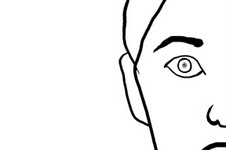
Reduction
Sam Barnett - 2009, 5:41, Animation, Los Angeles
Reduction Is an animated film in which psychological Processes in a man’s subconscious, such as impulses to suppress disorienting thoughts, exist as ameba like organisms in the chaotic ocean of his mind. Thoughts join and new thoughts are born and attempt to take root in the man’s subconscious. When a mutated thought threatens to destabilize the man’s consciousness he must learn how to destroy thoughts by reducing them into a standard form. When he gains the power to reduce thoughts, reduction becomes compulsion, and the world is reduced.
Reduction is the 4th in a series of animations by Sam Barnett that utilize sound as a primary force in the narrative. Simple images are made complex by the sounds that define them, turning the ideas in the images into visceral objects and characters.

Sam was born to an atheist and a nun turned pagan in Colorado. Many years later he discovered his love for film making in California and expects he will be eaten at some point by a wild animal.
Interview
ATA: Like Breathe (from the 2009 festival), Reduction seems to be driven by a sort of emotional or subconscious logic. Do you see your work as a continuum of similarly organized work, and if so, can you name any favorite titles?
SB: For this work specifically, I was thinking about William Kentridge quite a bit. It is because of him that I moved from the white board used in Breathe to charcoal for parts of Reduction. Of course the relationship is much deeper than just the medium. I think in some of his films he manages to use abstraction to really get at some deep emotional stuff. Stereoscope has some blue lines that go right through my face. Six Men Getting Sick Six Times by Lynch has influenced my work for sure. Formally, Guy Madden has affected the film I am working on now quite a bit. Brand Upon The Brain! Is my favorite. Un Chen Andalou by Dali and Bunuel has been a major influence for a long time.
ATA: I see a negative tension between organic forms (such as human bodies) and inorganic shapes (boxes). I'm wondering if this is symbolic or an expression of a dystopian point of view.
SB: I don't think that it is an insurmountable problem, but I do think there is an inherent tension between the fluid reality we experience and the systems we must build to make sense of it all. We have to divide things up, cut them up, put them in boxes. We can't think about a "Tree" without defining it as something that is distinct from everything that is not a "tree". Once you give something a name like this, It becomes a finite object in the mind. You gain control over the idea of "tree", but you also sort of kill your ability to actually perceive a real tree, a specific tree. Like, a budding artist can immediately draw the symbol of a tree we all learn in school, but will spend years learning to actually see the infinitely complex shapes that make up an actual tree if he tries to draw one. The point is that once we feel we understand something well enough to give it a word, it becomes that word, and from that point forth we tend to relate to the symbol of tree rather than to the tree. Our relationship to "tree" becomes static. The more we name things, the more we stop perceiving the world, and the more we live inside our head. Inside our head where we control things and things are static and dead. So the film is about compulsively trying to expand that kind of control and the paradoxical destruction it may cause. But like the artist that keeps trying to see what is behind the word, we can work to undermine the limitations we impose on ourselves as a result of our need to have control.
Interview by Liz Wing of ATA


